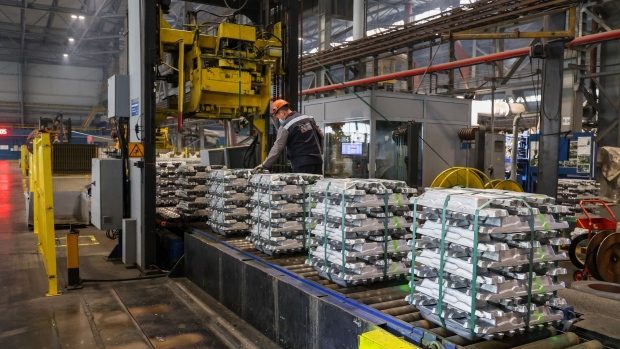Oct 12, 2022
Aluminum Heads For More Supply Chaos as Biden Weighs Russia Ban
, Bloomberg News

(Bloomberg) -- Aluminum extended gains on the prospect of a complete US ban on supplies from Russia, which threatens to upend a global market already reeling from multiple disruptions.
The Biden administration is considering options including sanctions on Russia’s top producer of the metal as the White House looks to punish Moscow for its military escalations in Ukraine, according to people familiar with the deliberations. The measures would add to a tumultuous year of price swings, supply shifts and demand turmoil in the wake of Russia’s February invasion.
“In a scenario of sanctions against Russian aluminum, the western aluminum market would be exposed to extreme tightening,” Goldman Sachs Group Inc. wrote in a note. Prices would rise much higher and China would export more semi-processed aluminum, the bank’s analysts including Nicholas Snowdon wrote.
Sanctions on United Co. Rusal International PJSC would be the most consequential of the options under consideration, which also include a US import ban and punitive tariffs on Russian supplies. Russia is the world’s second-biggest supplier of aluminum after China.
Aluminum prices surged to a record in March in the immediate aftermath of Russia’s attack, but have receded as metal from the country has largely kept flowing to global markets. Europe’s energy crisis has also pummeled demand and shuttered smelters there, while the London Metal Exchange has separately opened discussions about banning new Russian metal from its warehouses.
Stockpiles of aluminum held by the bourse have begun to rise recently, with metal immediately available to withdraw up the most in a month on Thursday. It’s a sign of supply beginning to out-pace demand as the global economy weakens.
Aluminum rose 2.8% to $2,370.50 a ton on the LME by 11:04 a.m. local time Thursday, after posting one of its biggest intraday spikes on record the previous day, following reports about the White House’s discussions. Rusal’s shares in Hong Kong dropped as much as 8.1%.
Stranded Aluminum
“The worst scenario is Europe and the US will block Russian aluminum,” Shanghai-based Chaos Ternary Research Institute wrote in an emailed note. “Stranded Russian aluminum will most likely flow to China, India and elsewhere, followed by China’s exports of aluminum products into Europe and the US to fill the gap.”
China is by far both the world’s biggest producer and consumer of aluminum. Under a potential reconfiguration of trade flows, metal from Russia could be used by its domestic industries, with China then boosting overseas sales of its own metal along its well-established export routes, Wei Lai, an analyst with TF Futures, said by phone from Shanghai.
There is precedent for curbs on Rusal. In 2018, the US placed sanctions on the firm as relations with Russia soured, triggering so much turmoil in the market that the measures were rolled back in early 2019. At the time, there was also much speculation about whether Russian aluminum could flow to China, and Rusal’s billionaire founder Oleg Deripaska even visited Beijing to discuss cooperation.
Beyond the upheaval to global trade flows, sanctions against Rusal could ultimately create additional strains on the company’s smelting operations, which are already facing restrictions on imports of raw materials and key industrial software and equipment.
“We’re assuming the production still comes, but there’s clearly a growing risk that something goes wrong and they’ll have to shut down a plant,” Colin Hamilton, managing director for commodities research at BMO Capital Markets, said by phone. “We think this will be a primarily be a reshuffling of the deck, and that Russian aluminum will still be produced, but perhaps no-one will want it.”
©2022 Bloomberg L.P.






